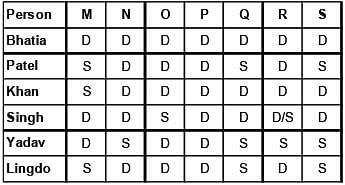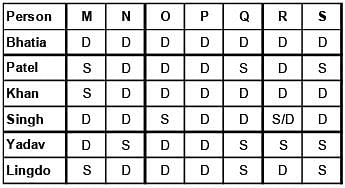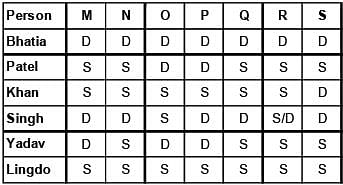XAT 2016: LR DI - CAT MCQ
23 Questions MCQ Test - XAT 2016: LR DI
Analyse the following caselet and answer the questions that follow:
Kamal Chinnappa, Vimal Rao, Ganesh Krishnan and Dinesh Kumar own a saloon each on the Barbil street. They are the only hairdressers on that street. Each of them offered three services viz. haircut, shaving and hairdye. One evening, all four of them met in a nearby teastall and agreed to charge ₹100 for any of the three services (haircut, shave and hair-dye) on weekdays. They also agreed to increase this rate to ₹115 on weekends and holidays. All verbally decided to implement the agreement.
The following day Kamal, being the most competent hairdresser on the street, was contemplating charging higher than agreed upon price.
Q. Which of the following would enable him to charge more with minimal violation of the agreement?
Analyse the following caselet and answer the questions that follow:
Kamal Chinnappa, Vimal Rao, Ganesh Krishnan and Dinesh Kumar own a saloon each on the Barbil street. They are the only hairdressers on that street. Each of them offered three services viz. haircut, shaving and hairdye. One evening, all four of them met in a nearby teastall and agreed to charge ₹100 for any of the three services (haircut, shave and hair-dye) on weekdays. They also agreed to increase this rate to ₹115 on weekends and holidays. All verbally decided to implement the agreement.
Vimal relies heavily on a bunch of loyal customers. He is concerned about retaining them.
Q. Which of the following options should he choose if he does not want to violate the agreement?
| 1 Crore+ students have signed up on EduRev. Have you? Download the App |
Analyse the following caselet and answer the questions that follow:
Chatterjee, the MLA of Trikathapur, owes his election success to his close friend and businessman Ghosh. The victory had appeared unlikely for Chatterjee after the arrival of Bhowmick, a budding politician with hordes of money. However, his clean image along with Ghosh’s money ensured Chatterjee’s resounding victory.
After the elections, Ghosh requested Chatterjee to sanction the land adjoining his factory, for expansion. However, the requested government land was a green belt reducing harmful pollution from the factory.
Q. Which of the following is the BEST option for Chatterjee in these circumstances?
Analyse the following caselet and answer the questions that follow:
Chatterjee, the MLA of Trikathapur, owes his election success to his close friend and businessman Ghosh. The victory had appeared unlikely for Chatterjee after the arrival of Bhowmick, a budding politician with hordes of money. However, his clean image along with Ghosh’s money ensured Chatterjee’s resounding victory.
Inspired by Bhowmick’s manifesto, Chatterjee is contemplating a green policy which can adversely affect Ghosh’s business interests.
Q. Which of the following actions from Ghosh is likely to convince Chatterjee NOT to pursue this policy?
Analyse the following caselet and answer the questions that follow:
The City of Yashmund is served by licensed taxis operating on officially sanctioned metered rates and driven by licensed drivers who do not own the taxis hut pay a monthly rent to the taxi-owners. Shaliesh Nair, the mayor ofYashmund, perceived that most of these taxis do not offer sufficient comfort and safety to passengers.The Mayor wants the owners and drivers to care about comfort.
Q. Which of the following decisions, IF TAKEN, is MOST LIKELY to increase the comfort levels of passengers?
Analyse the following caselet and answer the questions that follow:
The City of Yashmund is served by licensed taxis operating on officially sanctioned metered rates and driven by licensed drivers who do not own the taxis hut pay a monthly rent to the taxi-owners. Shaliesh Nair, the mayor ofYashmund, perceived that most of these taxis do not offer sufficient comfort and safety to passengers.
The mayor wants to involve the car owners in finding a solution to the problem of comfort and safety. He is concerned that the customers may not be willing to pay more for safety.
Q. Which of the options below is MOST LIKELY to convince the owners?
Analyse the following caselet and answer the questions that follow:
Indian Institute of Research is a Government-established body to promote research. In addition to helping in policy making, it also provides free online access to all the articles to the public. It has a mission of publishing high quality research articles. Till 2010, the publication of articles was very slow because there was no incentive for researchers to publish. Researchers stuck to the mandatory one article a year. Most of the researchers engaged in offering consultancy and earned extra income. Since its inception, the institute was considered the best place for cutting edge research. The new director of the institute was not happy with the work done by researchers in silo and came out with a new research policy in 2013 to increase research output and improve collaboration among researchers. It was decided that extra benefits would be offered to researchers with new publications. As a result, the number of research articles increased fourfold in 2014. At the 2015 annual audit, an objection was raised against the new benefits scheme. Auditors' were not happy with increased expenses towards remuneration for researchers. Further, the Government opined that the publication was itself a reward and hence researchers need be paid nothing extra. The director tried to defend his policy but the response from the government was not encouraging.
The following facts were observed by an analytics team hired by the government to study the extant situation.
1. There was a four-fold increase in the number of researchers leaving the organization in 2014.
2. A researcher died while on duty.
3. The quality of articles published declined substantially.
4. The average number of people accessing an article decreased by 2%.
Q. Which of the following options would justify the government's intention to DISCONTINUE the scheme?
Analyse the following caselet and answer the questions that follow:
Indian Institute of Research is a Government-established body to promote research. In addition to helping in policy making, it also provides free online access to all the articles to the public. It has a mission of publishing high quality research articles. Till 2010, the publication of articles was very slow because there was no incentive for researchers to publish. Researchers stuck to the mandatory one article a year. Most of the researchers engaged in offering consultancy and earned extra income. Since its inception, the institute was considered the best place for cutting edge research. The new director of the institute was not happy with the work done by researchers in silo and came out with a new research policy in 2013 to increase research output and improve collaboration among researchers. It was decided that extra benefits would be offered to researchers with new publications. As a result, the number of research articles increased fourfold in 2014. At the 2015 annual audit, an objection was raised against the new benefits scheme. Auditors' were not happy with increased expenses towards remuneration for researchers. Further, the Government opined that the publication was itself a reward and hence researchers need be paid nothing extra. The director tried to defend his policy but the response from the government was not encouraging.
The director still wanted to persuade the government to review its stand. He had framed the following arguments:
1. Most famous researchers in the world are also the highest paid.
2. American institute of research gives extra benefits to its scientists.
3. This year's highest paid researcher had won the Nobel Prize last year.
Q. Considering the Government to be reasonable which of the following options is UNLIKELY to convince the Government?
Analyse the following caselet and answer the questions that follow:
Indian Institute of Research is a Government-established body to promote research. In addition to helping in policy making, it also provides free online access to all the articles to the public. It has a mission of publishing high quality research articles. Till 2010, the publication of articles was very slow because there was no incentive for researchers to publish. Researchers stuck to the mandatory one article a year. Most of the researchers engaged in offering consultancy and earned extra income. Since its inception, the institute was considered the best place for cutting edge research. The new director of the institute was not happy with the work done by researchers in silo and came out with a new research policy in 2013 to increase research output and improve collaboration among researchers. It was decided that extra benefits would be offered to researchers with new publications. As a result, the number of research articles increased fourfold in 2014. At the 2015 annual audit, an objection was raised against the new benefits scheme. Auditors' were not happy with increased expenses towards remuneration for researchers. Further, the Government opined that the publication was itself a reward and hence researchers need be paid nothing extra. The director tried to defend his policy but the response from the government was not encouraging.
The director wanted to promote good decision making at Indian Institute of Research. A few trusted colleagues offered the following suggestions:
1. Auditors need not be allowed to object to extra benefits schemes.
2. Auditors need not pin-point sudden increase in expenditure.
3. Auditors need not be consulted before taking any policy level decision.
Q. Which of the following combination of options should the director agree THE MOST with?
Analyse the following caselet and answer the questions that follow:
Purushottam Bhatnagar owns and operates a sweetshop Puru and Sons. He is about 60 years old and is eager to hand over the business to his sons Ratan and Pramod. He however, fears that his sons, fresh from college may not understand the tricks of the trade.
Purushottam sends a batch of sweets to the Police station across the street every day. Ratan construed it as a bribe and wanted to stop this practice.
Q. Which of the following arguments, IF TRUE, would BEST convince Ratan NOT to give up this practice?
Analyse the following caselet and answer the questions that follow:
Purushottam Bhatnagar owns and operates a sweetshop Puru and Sons. He is about 60 years old and is eager to hand over the business to his sons Ratan and Pramod. He however, fears that his sons, fresh from college may not understand the tricks of the trade.
Purushottam's eldest son discovered that the shop repackaged sweets that were close to expiry and sold them at a discount under different names. These sweets usually get sold very fast. But his son was concerned about the possible consequences of this practice. Purushottam was thinking of the following arguments to convince his son.
1. These sweets are consumed the same day and therefore there is no cause for worry.
2. Reduced prices give enough indication about the sweets to the customers.
3. These products are preferred by those who cannot afford full price and, in a way, this is a service done to them.
4. In the past 30 years not a single person has reported ill because of consumption of these sweets.
5. Repackaging and selling sweets is a common practice.
Q. Which combination of arguments below is MOST LIKELY to convince Ratan?
Analyse the following caselet and answer the questions that follow:
Purushottam Bhatnagar owns and operates a sweetshop Puru and Sons. He is about 60 years old and is eager to hand over the business to his sons Ratan and Pramod. He however, fears that his sons, fresh from college may not understand the tricks of the trade.
Purushottam's younger son Pramod discovered that 10% of their customers whom Purushottam called privileged customers purchased sweets at prices fixed 10 years ago (which is significantly lower than the current prices). Purushottam told him, "This 10% are my core and loyal customers with whom I have personal connect and therefore they deserve this privilege". Pramod refuted his father's argument citing the following information.
1. These customers form the top 20% of the income bracket of the city.
2. These customers frequently purchase from other sweetshops at market prices.
3. None of them recognises and greets Purushottam at the shop or at anywhere else.
4. None of them was present at Pramod's marriage.
5. These customers actually buy sweets at Puru and Sons for others not part of the core and loyal customer group.
Q. Which of the following combination of the above will MOST LIKELY convince Purushottam to charge market price to all?
Analyse the following caselet and answer the questions that follow:
Nicky, Manoj and Benita are graduates from a top ranked B-school. They joined ABC corporation a year ago. ABC is known for its performance-oriented culture. This is the first time the organization recruited from a top ranked Bschool. They are part of a five-member team with two others from lower ranked B-schools. Nicky, Manoj and Benita draw 40 per cent higher salaries than other team members. This team reports to Amelia Ganeshmurthi, a senior executive.
Amelia is disappointed with the performance of Nicky, Manoj and Benita. She came to know that ABC was not their first choice and they had spent the first ten months applying to other organizations. However, they have now started liking ABC and promised to do their best henceforth. Amelia has to rate their annual performance and decide about their future. She has the following choices:
1. Fire them from ABC for insincerity and save the organization's time and money.
2. Give them average ratings with a year to prove their worth and fire them from ABC if they fail to show significant progress.
3. Impose a pay-cut of 15% since they have not delivered on the promise, but give them relatively high ratings.
4. Give them relatively poor ratings with one-year time to improve and fire them from ABC if they fail to show significant progress.
5. Give them high ratings and give them a second chance to prove their worth.
Q. Which of the following options rank the above choices in the order of MOST APPROPRIATE to LEAST APPROPRIATE?
Analyse the following caselet and answer the questions that follow:
Nicky, Manoj and Benita are graduates from a top ranked B-school. They joined ABC corporation a year ago. ABC is known for its performance-oriented culture. This is the first time the organization recruited from a top ranked Bschool. They are part of a five-member team with two others from lower ranked B-schools. Nicky, Manoj and Benita draw 40 per cent higher salaries than other team members. This team reports to Amelia Ganeshmurthi, a senior executive.
Recruiting Nicky, Manoj and Benita was part of a larger initiative to make the organization attractive to prospective employees. Recently Amelia’s boss informally told her that the trio’s perception of the organization might influence future recruitment from top B-schools. However, the trio had already expressed their unhappiness about the organization to Amelia. She suspected that her promotion due next year might depend on the trio!
Q. Which of the following is the BEST way for Amelia to deal with this situation?
Analyse the following caselet and answer the questions that follow:
Nicky, Manoj and Benita are graduates from a top ranked B-school. They joined ABC corporation a year ago. ABC is known for its performance-oriented culture. This is the first time the organization recruited from a top ranked Bschool. They are part of a five-member team with two others from lower ranked B-schools. Nicky, Manoj and Benita draw 40 per cent higher salaries than other team members. This team reports to Amelia Ganeshmurthi, a senior executive.
'Nicky's performance on the job is disappointing though she is considered a very helpful person outside the workplace helping her teammates and others in the organization with their personal needs e.g., finding a place to rent, a good place to get homely food etc. On the other hand, Manoj and Benita are performing well in their respective jobs and are perceived by their teammates as important to the team. But they are not interested in helping outside the workplace. Amelia has to decide the future of the trio. She has the following options:
1. Inform the higher authorities about Nicky's poor performance and ask them to take a call.
2. Send Nicky for a one-month training earmarked for top performing employees.
3. Serve Nicky an ultimatum to improve within the next six months or get fired.
4. Even though they performed well, give Manoj and Benita average ratings because of their disinterest in helping outside workplace.
5. Give Manoj and Benita high ratings based on their performance.
Q. Which of the following combination of above options will be the MOST APPROPRIATE?
Analyse the following caselet and answer the questions that follow:
Six people working at the Bengaluru office of Simsys are planning to buy flats at a real estate project at Whitefield. Their preferences are listed below:

They have identified 7 real estate projects with following facilities available (marked with V):
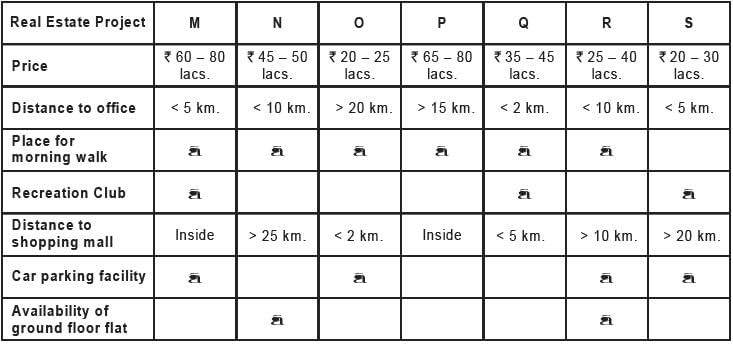
A person is 'satisfied' if a project meets all three preferences.
Q. Identify the project(s) where NONE of the 6 persons will be 'satisfied'.
Analyse the following caselet and answer the questions that follow:
Six people working at the Bengaluru office of Simsys are planning to buy flats at a real estate project at Whitefield. Their preferences are listed below:
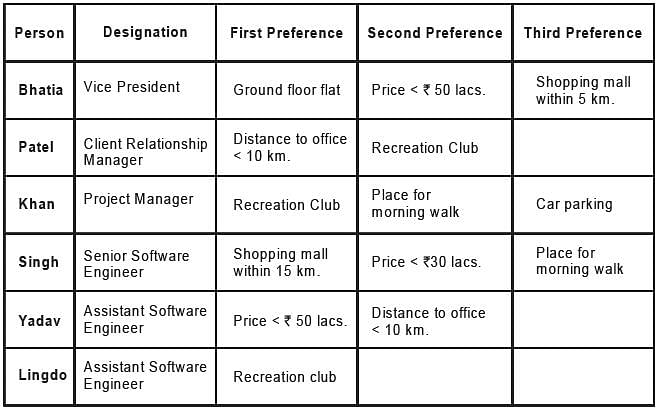
They have identified 7 real estate projects with following facilities available (marked with V):
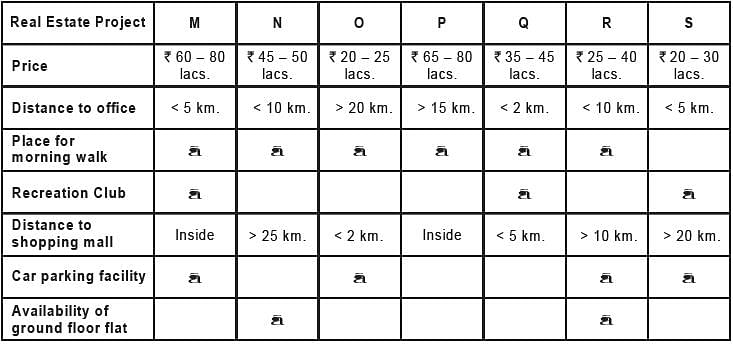
A person is 'satisfied' if a project meets all three preferences.
Q. Identify the project(s), where AT LEAST 3 of the 6 persons will be 'satisfied'.
Analyse the following caselet and answer the questions that follow:
Six people working at the Bengaluru office of Simsys are planning to buy flats at a real estate project at Whitefield. Their preferences are listed below:

They have identified 7 real estate projects with following facilities available (marked with V):
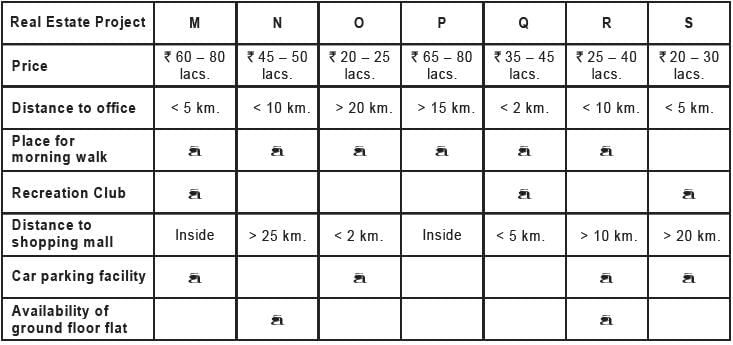
A person is 'satisfied' if a project meets all three preferences.
The marketing managers of all the six projects have agreed to add a recreation club and a car parking facility to the projects.
Q. In this changed scenario identify projects where AT MOST 2 of the 6 persons will NOT be 'satisfied'.
Analyse the following caselet and answer the questions that follow:
Recently a private food testing agency reported the presence of a harmful chemical in Crunchy Chips, a product of a fast-moving consumer goods giant. The report sparked a nationwide outcry.
Rajan Shekhawat, the CEO of the company, feared this incident might affect the company's image among consumers. Rajan had the following options:
1. Apologizing publicly for this inconvenience and immediately withdrawing the products from all stores.
2. Communicate 'the correct findings' to the public.
3. Hire a reputed independent testing agency to verify the ciaitns of the report.
4. Establish internal mechanisms to prevent repetition of such incidences in future.
5. Give higher incentives to distributors and retailers for selling the company brands.
Q. Which of the following would be the MOST APPROPRIATE ORDER of options for Rajan, starting from the immediate?
Analyse the following caselet and answer the questions that follow:
Recently a private food testing agency reported the presence of a harmful chemical in Crunchy Chips, a product of a fast-moving consumer goods giant. The report sparked a nationwide outcry.
Mukesh Routray, a shopkeeper in a remote village was surprised to read in the newspaper, his only source of information, about harmful chemicals in Crunchy Chips. He had stocked a large quantity of Crunchy Chips for the forthcoming festive season. He also realized that people in his village are completely unaware of this controversy. He had the following options:
1. Sell the entire stock at a discount before the news spreads.
2. Destroy the entire stock and advise customers not to buy this product from other shops as well.
3. Donate the entire stock of Crunchy Chips to a local orphanage.
4. Inform customers about the controversy but understate its seriousness.
5. Ignore the news and sell the stock at the forthcoming festive season as planned.
6. Explore the veracity of the report and then take decision.
Q. If arranged from ethical to unethical which of the following is DEFINITELY the WRONG order?
Analyse the following caselet and answer the questions that follow:
Recently a private food testing agency reported the presence of a harmful chemical in Crunchy Chips, a product of a fast-moving consumer goods giant. The report sparked a nationwide outcry.
An independent and trustworthy confidante of Raj an Shekhawat, the CEO of the company, informed him that one of their main competitors had bribed the food testing agency to manipulate the report.
Q. Which of the following actions will BEST help Crunchy Chips to bounce back?
Analyse the following caselet and answer the questions that follow:
Geetha Gawde can cultivate up to 6 crops a year. Crop A and B arc ready for harvest in 2 months; crop C and D in 3 months, and crop E and F in 4 months. Crop A can be cultivated from January to June; crop B can be cultivated from April1 to September; crop C can be cultivated from May to December; crops D as well as E can be cultivated from August to December, and crop F from November to Mgy. If Geetha plans a change of crop the soil should be left fallow for one month; however, if the same crop is sown no fallow time is needed. Sowing takes place only at the beginning of a month. Geetha can only harvest a maximum of 1000 units of any crop at any point in time. The production cost per unit (incurred at the time of sowing) andpriceper unit of crop are as follows:
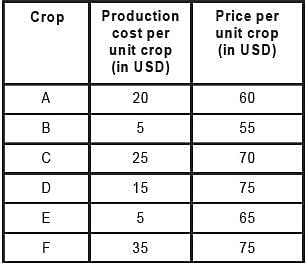
For Geetha soil preparation does not incur any cost. If a crop is abandoned before the scheduled harvesting, she gets no money. Geetha is preparing a cropping schedule to maximize her annual profits (i.e., price- cost). She plans to replicate the schedule in the coming years.
Q. Which of the following would DEFINITELY be a part of the ideal schedule?
Analyse the following caselet and answer the questions that follow:
Geetha Gawde can cultivate up to 6 crops a year. Crop A and B arc ready for harvest in 2 months; crop C and D in 3 months, and crop E and F in 4 months. Crop A can be cultivated from January to June; crop B can be cultivated from April1 to September; crop C can be cultivated from May to December; crops D as well as E can be cultivated from August to December, and crop F from November to Mgy. If Geetha plans a change of crop the soil should be left fallow for one month; however, if the same crop is sown no fallow time is needed. Sowing takes place only at the beginning of a month. Geetha can only harvest a maximum of 1000 units of any crop at any point in time. The production cost per unit (incurred at the time of sowing) andpriceper unit of crop are as follows:
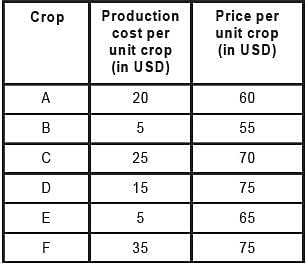
For Geetha soil preparation does not incur any cost. If a crop is abandoned before the scheduled harvesting, she gets no money. Geetha is preparing a cropping schedule to maximize her annual profits (i.e., price- cost). She plans to replicate the schedule in the coming years.
Q. Which of the following schedules would maximize her annual profit while minimising the costs, if Geetha decides NOT to repeat a crop in a calendar year?


